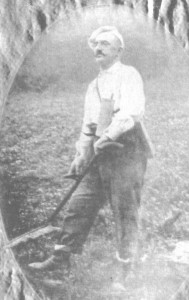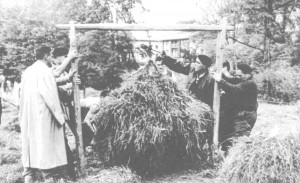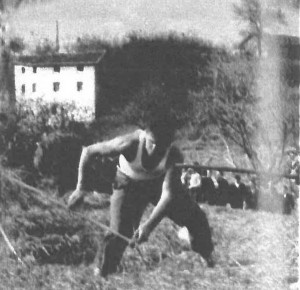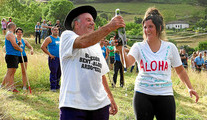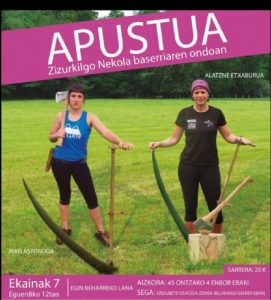The sport of mowing, like other rural sports, is originated in agricultural and farming jobs.
Considering the geographical characteristics of the Basque Country, the basque people couldn’t use the mowing machines in all their fields as so many did in other countries with large and wide valleys. Consequently, the Basques have had no other choice but using the scythe for this kind of jobs and so they became skilled with this tool.
It’s in fact in this rural area where they began playing the first duels of who was the most skilled one mowing or cutting the largest area. Even so, competitions didn’t begin until some years later as Basque mountains were full of forests until the eighteenth century .
The scythe
This tool requires an adapted design in order to have a good efficiency. The scythe is formed by a blade and a handle. The blade has the shape of a large radius arc and it’s usually of steel to assure hardness and durability. It has three parts:
1- The mouth
2- The edge
3- The head (it normally has a slot to attach to the handle)
The handle is usually made of wood and by the middle of the total length is supposed to have a mooring.
Although it seems that all the scythes have the same shape on the mooring and the curvature of the blade, they often use to have differences. The measures of standard scythes use to be between 120-180 cm in total length, 80-92 cm in blade length and 10 cm wide where the slot. Anyway, the scythes used in competitions are often personalized.
History
The first reference of a Basque reaper is from the mid-nineteenth century, Jose Iturrioz “Labisu” a deaf and dumb born in Asteasu. He was a burly and heavy young man, very appreciated to work in the farms. By 1880, thanks to several mentions of the bertsolaris (improvisers and verso singers) of that time, we know about a bet played in Iturriotz: Izuela from Aia against another unknown reaper. Anyway, the first mowing dispute known with more details was the one played between Izuela and Uria, from the farm Isasti in Zarautz. It was played in Usurbil and Uria beat it. Pedro Maria Otaño “Santageda” too was another well-known reaper of that period but he was better known as an aizkolari (trunk cutter).
One of the most important challenges of the history was the one played in 28th September, in 1925, between Pedro Mendizabal “Lokate” and Jose Arrieta “Prantsesa” Iturriotz. About seven thousand spectators joined and the bets among the spectators reached over 150,000 pesetas of that time (about current 900 €).
In the decades of twenties and thirties, besides those already mentioned, there have also been other distinguished reapers as Florentino Mayoz and John Kortajarena “Ondartza” both from Asteasu or Juan Antonio Maria Mendizabal and Migel Otaño, the son of the great Santageda. We could mention anecdotally that during this period many mowing bets were played at football grounds, it was profited to cut the growing grass as there were no football matches from May onwards. In addition, it was an adequate space to limit the plots and to have a good visibility of the dispute.
In the forties, as they were postwar years of the civil war, there wasn’t much variety of leisure events so mowing disputes collected many viewers. Two bets played in 1943 deserve a special mention, the one played between Pedro Huegun and Secundino Egiguren and the other one played between Serapio Mujika “Lizume” and Domingo Usandizaga “Ibiya”. The disputes were usually two hours long and for example, in this mentioned one Ibiya cut 5.533kg of grass and Lizume 5.002kg.
In the fifties two bets were played In Usurbil, just on the two islets in the middle of the Oria river: on that of Sumao and on that of Zumaburu. It was in this last one, in 1955, where it became known the reaper that in the next years would be a great champion, Eleuterio Tapia from Asteasu. It also debuted at this time Migel Irazusta Goikoetxea “Polipaso”. Most of the distinguished reapers were from the province of Gipuzkoa, that’s why most of the fans ere also from this area. As example, many well-known reapers were born in Asteasu. In 1957 Jose Txapartegi Vitoria “Izurtzu” from Asteasu and Polipaso played a bet and unexpectedly, it was the first one to win cutting 8,955 kilos of grass.
In the sixties the same reapers were still working hard. As revenge to the bet played in 57, Izurtzu and Polipaso replayed another dispute in the fields of Jauregi in Hernani, but this time was Polipaso to win. In 1964, it was played one of the most equalized disputes in the history of mowing: Jose maria Zulaika “Paskualsoro” against Jose Aburuza from Oiartzun. Paskualsoro won it.
The first known reference of a female reaper in a bet is from 1967. It was played by Maria Asuncion Azeok and Antonio Larrazak. After an hour of work, the man had to cut twice a kilo of grass than the woman. Antonio cut 2.325 kilos and Asuncion 1.896 kilos, therefore she won the bet. Some months later she played against Polipaso, one of the best of the time, under the same conditions as the previous bet. Polipaso cut 2.193 kilos and Asuncion 1.652 kilos, so she won the bet again. The next bet in which played a woman did not take place until 2013. It was played between Irati Astondoak and Joakin Garmendia in Anoeta (Gipuzkoa), this time on equal conditions. The winner was Joakin Garmendia.
Two years later, a challenge between two women reapers was played for the first time in history. Woodchopping with axe and mowing, Irati Astondoak and Alatzne Etxaburua had to do both works. Although Irati Astondoa was the first on woodchopping, Alatzne was better mowing. Alatzne cut 1.496 kilos of grass in total and Irati 1.279 kilos. Finally the winner was Alatzne Etxaburua.
From 1965 on, they began to organize the Basque Country Championship which gradually went defining the rules of what we nowadays know as the modality of the Basque Country.


